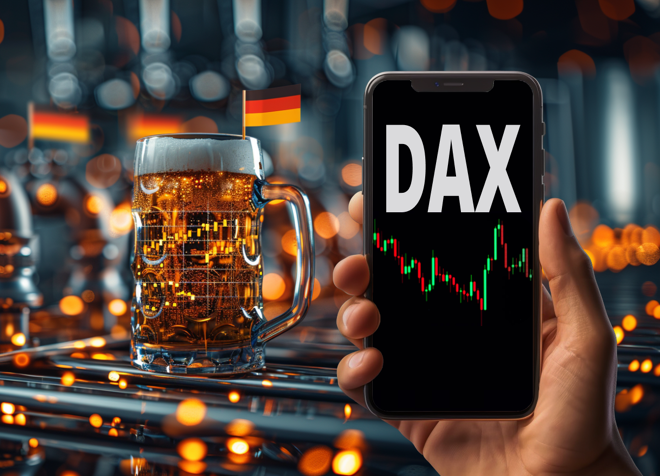Advertisement
Advertisement
Dax Index News: Will the Fed’s Rate Decision Push DAX to New Highs? Forecast Today
By:
Key Points:
- DAX surges 0.98%, fueled by Zalando’s 10.30% rise and Siemens’ 9.44% gain as Fed rate cut speculation heats up.
- Oxford Economics warns that Eurozone industry contracted deeper than expected, signaling weak German economic data.
- Eurozone trade data expected to show a narrowing surplus, fueling ECB rate cut expectations for December.
Market Overview
On Friday, September 13, the DAX gained 0.98%, following a 1.03% rally from the previous day, closing at 18,699.
Key DAX Market Movers
Online retailer Zalando SE surged by 10.30%, while Siemens Energy rallied 9.44% as investors raised expectations about a more dovish Fed rate path.
Auto stocks also trended higher, benefiting from expectations of lower borrowing costs. BMW and Volkswagen recorded gains of 2.75% and 2.69%, respectively. Porsche advanced by 2.53%.
Eurozone Industrial Production Falls
On Friday, Eurozone industrial production numbers supported expectations of a December ECB rate cut. Industrial production fell by 0.3% in July after stalling in June. Accounting for around 30% of the Eurozone economy, weaker manufacturing sector output could impact jobs, private consumption, and the broader economy.
Expert Views on the Eurozone Economic Data
Danial Kral, a European Macro Specialist at Oxford Economics, commented on the industrial production report, stating,
“Rather than a bounce in early Q3, Eurozone industry sunk deeper into contraction. And it’s even worse than it looks, as fantasy Irish numbers were up 10% m/m, adding almost 1ppt to Eurozone growth. Without this, Eurozone would have contracted by 1.2% led by very weak Germany.”
Upcoming Eurozone Trade Data
On Monday, September 16, Eurozone trade data will draw investor interest. Economists expect the trade surplus to narrow from €22.3 billion in June to €14.9 billion in July. Weaker imports and exports would signal weaker demand, supporting bets on a December ECB rate cut to bolster the economy.
US Economic Data Raise Bets on a 50-Basis Point Fed Rate Cut
On Friday, the Michigan Consumer Sentiment Index rose from 67.9 in August to 69.0 in September. Rising consumer confidence could support consumer spending and the US economy as it accounts for over 60% of GDP. Additionally, the Michigan Inflation Expectations Index dropped from 2.8% to 2.7%, boosting expectations of a 50-basis point Fed rate cut.
According to the CME FedWatch Tool, the chances of a 50-basis point September Fed rate cut increased from 30.0% on September 6 to 57.0% on September 16.
The combination of easing recession fears and expectations of a more dovish Fed rate path fueled demand for riskier assets.
US Market Trends
On Friday, September 13, the US equity markets continued to extend gains from the previous session. The Dow advanced by 0.72%, while the Nasdaq Composite Index and the S&P 500 saw gains of 0.65% and 0.54%, respectively.
Upcoming US Economic Data
On Monday, September 16, the NY Empire State Manufacturing Index will be in focus. Economists expect the Index to increase from -4.7 in August to -3.9% in September. Weaker-than-expected data could fuel bets on a 50-basis point September Fed rate cut. However, a significant fall could rekindle fears of a US economic recession, possibly affecting market risk sentiment.
Near-Term Outlook
Near-term DAX trends will likely hinge on Wednesday’s Fed interest rate decision and forward guidance. A 50-basis point Fed rate cut and confidence toward a soft US economic landing could push the DAX toward 19,000. Conversely, a 50-basis point interest rate cut and concerns about the economic outlook may pull the DAX down toward 18,000.
In the futures markets, the DAX was up 31 points, while the Nasdaq mini was down by 3 points.
Investors should stay alert to central bank chatter and economic indicators. Stay informed with our latest news and analysis to manage your risks effectively.
DAX Technical Indicators
Daily Chart
The DAX remains above the 50-day and 200-day EMAs, affirming bullish price signals.
A return to 18,750 could support a move toward the all-time high of 18,991. Furthermore, a breakout from 18,991 may give the bulls a run at 19,200.
Eurozone trade data, US manufacturing sector numbers, and central bank commentary need consideration.
Conversely, a drop below 18,500 could bring the 50-day EMA into play.
The 14-day RSI at 57.41 indicates a climb to the all-time high before entering overbought territory.
About the Author
Bob Masonauthor
With over 28 years of experience in the financial industry, Bob has worked with various global rating agencies and multinational banks. Currently he is covering currencies, commodities, alternative asset classes and global equities, focusing mostly on European and Asian markets.
Advertisement
